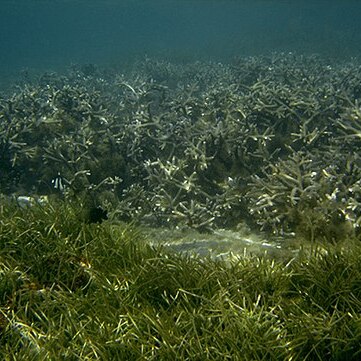Plants herbaceous, perennial, submersed in saline water, dioecious. Rhi-zomes creeping, monopodial, with one or more roots and a short erect stem at each node. Leaves 2-3 on each stem, divided into a sheath and a blade; sheath broad, persisting longer than the blade, leaving open circular scars when shed, bi-auriculate, stipulate, the auricules obtuse; blades linear, often narrowed at the base. Inflorescence cymose, the lower branches dichasial, the upper mono-chasial. Flowers axillary to a reduced leaf, the sheath of which is inflated; peri-anth absent; staminate flowers stalked, each consisting of 2 anthers dorsally con-nate at their lower parts and attached at the same height on the stalk; carpellate flowers sessile, each consisting of 2 distinct ovaries, each with a short style which divides into 2 long stigmata. Fruits achene-like with a stony pericarp, ellipsoid to obovoid, quadrangular in cross section and with an inconspicuous dorsal me-dian ridge.
Marine, submerged herbs. Rhizome herbaceous, monopodially branched, with 1 or more branched roots and a short erect stem at each node; scales scarious, oblong to ovate. Stem herbaceous, rarely branched, with 2–4 leaves. Leaf sheath persistent after blade is shed, leaving an open circular scar. Leaf blade distinctly terete, gradually tapering off to a point at apex, entire; longitudinal veins inconspicuous. Inflorescences on terminating erect floral shoots, branching racemose below, cymose above, many-flowered; each flower enclosed in a reduced leaf with an elliptic to ovate and inflated sheath and short blade. Male flower stalked; anthers at same level, dorsally connate at lower parts, without apical appendage. Female flower: style short, with 2 stigmas. Fruit ellipsoid, ridged; pericarp stony; beak 2-branched.
Submerse aquatic herbs; rhizome creeping, monopodial, with many vascular bundles; each node with 1 or more unbranched or slightly branched roots and ashort erect stem bearing 2– 3 leaves; scales scarious, ovate, acute. Leaf with broad sheath persisting longer than blade, bi-auriculate, ligulate, scars open; blade subulate with single central and several pericentral vascular bundles and 6– 8 air channels. Inflorescence cymose; flower enclosed by reduced leaf with inflated sheath. Staminate flower stalked, of 2 anthers, dorsally connate at lower end, attached at same height. Pistillate flower sessile, of 2 free ovaries, each with short style and stigmas. Fruit quadrangular in cross-section, with inconspicuous dorsal ridge; pericarp stony.
Stems erect, subtended by ovate scales. Leaves 2--3; blade terete or semi-terete, apex acute to obtuse, lacunae 2; veins 1--2[--7--10], midrib inconspicuous, not obviously widened distally, lateral veins inconspicuous, not ending in tooth. Inflorescences cymose. Flowers axillary to bract, inflated sheath present. Staminate flowers: anthers attached at same height on axis. Pistillate flowers sessile, styles divided into 2 long stigmas. Fruits drupaceous, obovoid [ellipsoid], quadrangular in cross section.
Rhizomes branched, rooting at nodes. Shoots erect, with leaves 2 or 3, alternate, subulate-terete; sheaths broader, auriculate, ligulate. Plants dioecious; flowers in terminal cymes, enclosed in a leaf. Male flowers pedunculate, consisting of 2 equally inserted anthers, without filament; pollen filiform. Female flowers sessile; carpels free; style short, divided into 2 filiform stigmas. Fruitlet with bony pericarp, beaked.

